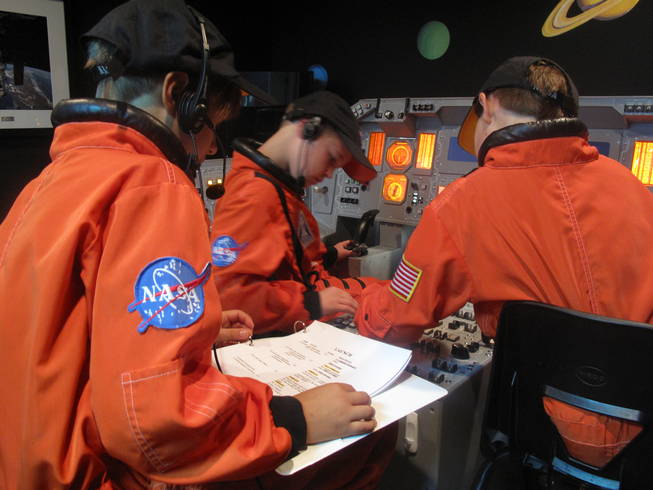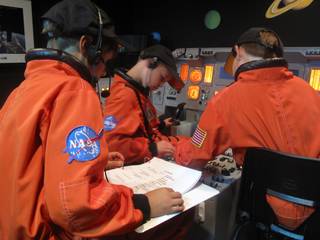
Sam Scow, Max Czerwinski and Cole Samson - fifth-graders at Frank Lamping Elementary School - work together in the NASA space shuttle simulator at the school’s William McCool Science Center on Oct. 6. The school installed a brand-new simulator, which replaced one of the first of its kind in the U.S., at the beginning of the school year.
Thursday, Oct. 7, 2010 | 1:55 a.m.
Beyond the Sun
Map of Frank Lamping
Simon Blackhurst radios from the mission control desk: “Helium pressure is stable.” After giving the go-ahead to his crew to initiate the launch sequence, he and his partners, Faith Schuck and Cayleigh Barnewolt, begin the 10-second countdown.
And then the room starts to shake slightly, as the space shuttle crew next door takes flight to orbit Earth.
Except, of course, it doesn’t because this isn’t Houston. It’s Frank Lamping Elementary School in Henderson and the newly installed NASA space shuttle simulator in the William McCool Science Center.
Blackhurst, the mission’s director, and his crew? Fifth-graders.
The new simulator, which opened in September, replaced a seven-year-old model that had been in place since 2005. When it was installed five years ago, it was one of the first simulators placed in a youth educational environment.
Teams of fourth- and fifth-grade students rotate through the simulator on a weekly basis, building teamwork skills and applying their classroom knowledge to the real world, said Lisa Almeido, a volunteer science instructor and parent who oversees the program.
The 3/4-scale model includes all of the manual controls in a NASA shuttle and an instruction manual, just like the one found in the cockpit of a working model. Crews prepare for launch, take the vessel on a (simulated) orbit around the Earth, and bring it back into Houston for a smooth landing.
And it all takes only 50 minutes.
For Almeido and teachers at the school, it’s important to see the students build and utilize problem-solving skills. The mission desk can initiate a number of emergency scenario and red lights and sirens often blare in the shuttle room.
“For 50 minutes, they’re completely enthralled,” said Almeido. “This is where they want to be.”
After all, when Blackhurst said the helium pressure was stable, he actually knew what that meant. And it’s fun.
Cole Samson, a fifth-grader on the shuttle crew, said wryly: “flipping all the buttons, it’s amusing in many ways.” Blackhurst, Schuck and Barnewolt agreed that having a chance to reenact a live shuttle flight is “pretty cool.”
Samson, along with his crewmates Max Czerwinski and Sam Scow, answered with an enthusiastic “yes” when asked if they’d thought about becoming real-life astronauts.
Combining fun with classwork makes the simulator, housed in a science center named for the pilot of NASA’s Columbia flight, such an effective tool for learning, said Robert Solomon, Lamping’s principal.
“You have kids now talking about careers in science,” he said. “They’re being exposed to things they typically read about in a book.”
That philosophy permeates through all of the school’s teaching, Soloman said. Students sent letters to real astronauts, who return them in kind with autographed pictures. Several hallways are lined with information about the planets and the Apollo missions.
Benches outside the William McCool Science Center memorialize the seven crewmembers killed with McCool on the Columbia in 2003. A foundation in his name started by McCool’s parents, who live in Henderson, sponsors a scholarship for graduating high school seniors pursuing degrees in science and technology.
The center, which opened in 2005 after a coordinated effort by the community and McCool’s parents, features a number of unique learning experiences: a greenhouse, a paleontology dig and a desert garden.
It’s not just Lamping students who benefit from the center, however.
The school has shared its unique facility with much of the valley; schools make routine stops at the center for field trips, Soloman said.
All of it relies on the generosity of local businesses and residents: almost half of the center’s $45,000 budget for 2010-2011 was raised at the school’s Run for the Stars event in September, Soloman said. The Clark County School District pays for utilities only.
The new simulator cost $70,000, paid for with a grant from NASA and the Total Research Institute, and should give plenty of future students a chance, like Samson, for a final countdown.
“3, 2, 1… Weeeee,” he and his crewmembers shouted as the room began to rumble.
Don’t worry, Mom and Dad: It’s science.


Join the Discussion:
Check this out for a full explanation of our conversion to the LiveFyre commenting system and instructions on how to sign up for an account.
Full comments policy